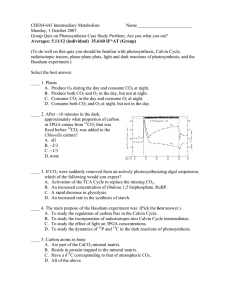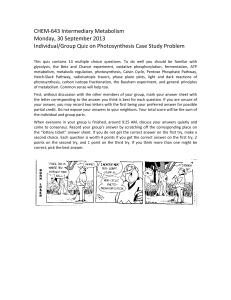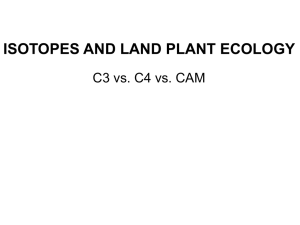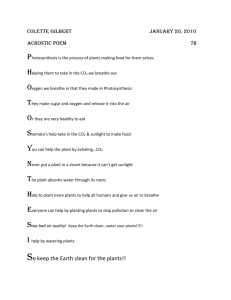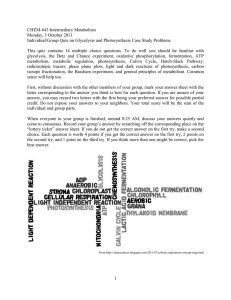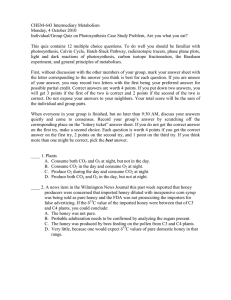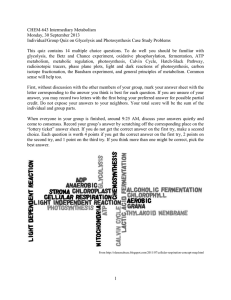CHEM-643 Intermediary Metabolism Name ________________________ Monday, 6 October 2008
advertisement
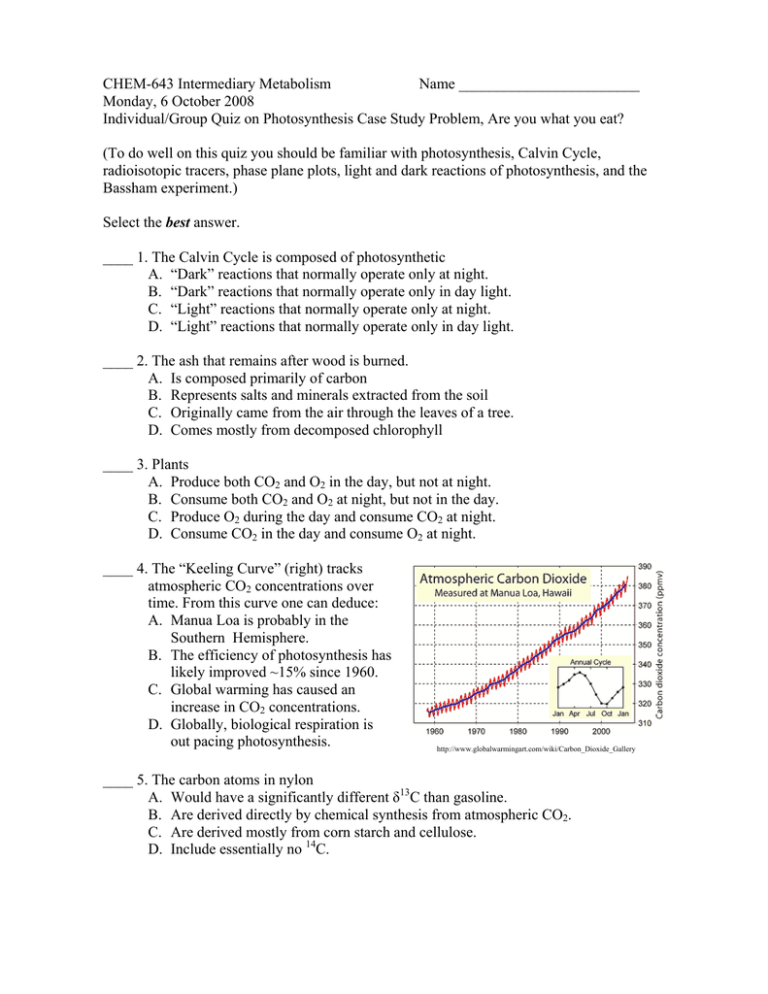
CHEM-643 Intermediary Metabolism Name ________________________ Monday, 6 October 2008 Individual/Group Quiz on Photosynthesis Case Study Problem, Are you what you eat? (To do well on this quiz you should be familiar with photosynthesis, Calvin Cycle, radioisotopic tracers, phase plane plots, light and dark reactions of photosynthesis, and the Bassham experiment.) Select the best answer. ____ 1. The Calvin Cycle is composed of photosynthetic A. “Dark” reactions that normally operate only at night. B. “Dark” reactions that normally operate only in day light. C. “Light” reactions that normally operate only at night. D. “Light” reactions that normally operate only in day light. ____ 2. The ash that remains after wood is burned. A. Is composed primarily of carbon B. Represents salts and minerals extracted from the soil C. Originally came from the air through the leaves of a tree. D. Comes mostly from decomposed chlorophyll ____ 3. Plants A. Produce both CO2 and O2 in the day, but not at night. B. Consume both CO2 and O2 at night, but not in the day. C. Produce O2 during the day and consume CO2 at night. D. Consume CO2 in the day and consume O2 at night. ____ 4. The “Keeling Curve” (right) tracks atmospheric CO2 concentrations over time. From this curve one can deduce: A. Manua Loa is probably in the Southern Hemisphere. B. The efficiency of photosynthesis has likely improved ~15% since 1960. C. Global warming has caused an increase in CO2 concentrations. D. Globally, biological respiration is out pacing photosynthesis. http://www.globalwarmingart.com/wiki/Carbon_Dioxide_Gallery ____ 5. The carbon atoms in nylon A. Would have a significantly different δ13C than gasoline. B. Are derived directly by chemical synthesis from atmospheric CO2. C. Are derived mostly from corn starch and cellulose. D. Include essentially no 14C. CHEM-643 Photosynthesis Quiz Monday, 6 October 2008 Page 2 ____ 6. The curve at the right displays the amount of 14CO2 remaining in the atmosphere as the result of atmospheric atomic bomb testing in the 1950s and 60s. If a 100 year old tree were cut down in 2005 and the 14C content of each annual growth ring was measured and plotted, the resulting graph of 14C vs time would: A. Look much like the graph at the right. B. Look like a saturation curve with highest values in 2005. C. Be flat corresponding to the highest point in 1968. D. Be flat corresponding to 2005 levels. ____ 7. The primary purpose of the Bassham experiment was: (Pick the best answer.) A. To study the regulation of carbon flux in the Calvin Cycle. B. To study the incorporation of radioisotopes into Calvin Cycle intermediates. C. To study the effect of light on 3PGA concentrations. D. To study the dynamics of 32P and 14C in the dark reactions of photosynthesis. ____ 8. The belemnite used as a δ13C reference standard and also the state fossil of Delaware A. Has a lower 13C/12C ratio than the carbon in either C3 or C4 plants. B. Is composed of hydroxyapatite, Ca5(PO4)3OH. C. Is an extinct type of mollusk related to squid and cuttlefish. D. Has a 14C/12C ratio similar to that in atmospheric CO2. ____ 9. The curve at the right displays the amount of 14C and 32P in (PGNA) 6-phosphogluconate in Bassham’s experiment. It shows that: A. After 15 min of darkness ≥60% of the carbon in PGNA comes from starch. B. The oxidative part of the pentose phosphate pathway operates only in the dark. C. PGNA is not part of the Calvin Cycle. D. All of the above. ____ 10. Ignoring photorespiration, the ratio of ATP:NADPH consumed per each CO2 fixed by the Calvin Cycle is __ in C3 plants:’ A. 2:1 B. 3:2 C. 1:1 D. 1:2 CHEM-643 Photosynthesis Quiz Monday, 6 October 2008 Page 3 0 ____ 12. The point on the graph to the right represents the concentrations of 3PGA and RuBP at the moment the lights were turned off in Bassham’s experiment. Plot the point corresponding to their concentrations about 30 sec later when [3PGA] peaks. What would be the expected slope (m = Δ[3PGA]/Δ[RuDP]) of the line connecting ● and the point you plotted? A. m ≤ -1 B. -1 < m < 0 C. 0 < m < 1 D. m ≥1 [3PGA] ____ 11. Consider two identical photosynthesizing leaves placed in separate vessels containing atmospheric carbon dioxide. Vessel 1 is sealed so new air cannot come in, while the Vessel 2 remains open to the air. Photosynthesis is allowed to continue until the CO2 in Vessel 1 is used up. What can you predict about the δ13C values for newly fixed carbon? A. δ13C atmospheric CO2 = δ13C Vessel 1 < δ13C Vessel 2 B. δ13C atmospheric CO2 < δ13C Vessel 1 < δ13C Vessel 2 C. δ13C atmospheric CO2 = δ13C Vessel 1 > δ13C Vessel 2 D. δ13C atmospheric CO2 > δ13C Vessel 1 > δ13C Vessel 2 . ● 0 [RuBP]
